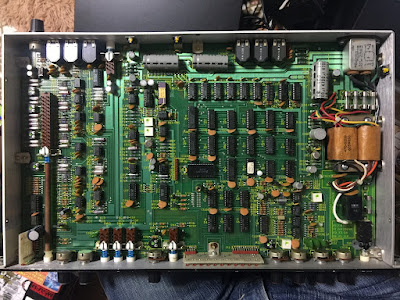Release and Production
The PCM 41 debuted in 1980, a time when digital audio was still finding its footing. Lexicon, already a pioneer in digital reverb with the 224, turned their expertise to delay with the PCM 41, offering up to 800 milliseconds of delay (200 ms at its full 16 kHz bandwidth). Exact production numbers are murky—Lexicon doesn’t publish this data—but estimates from vintage gear forums and resellers suggest a few thousand units were made during its run. By the mid-1980s, it was succeeded by the PCM 42, which offered longer delay times but retained the PCM 41’s sonic DNA. The limited production and its status as a studio staple mean finding a working unit today can feel like unearthing buried treasure.
 |
| Inside PCM 41 |
Processing Power
The PCM 41 uses 12-bit processing, a choice that might sound modest by today’s 24 and 32-bit standards but was a deliberate design triumph. Lexicon opted for true Pulse Code Modulation (PCM), rejecting analog bucket-brigade devices or delta modulation used in competing units. This 12-bit architecture, paired with a sampling rate of up to 50 kHz, delivered a full 16 kHz bandwidth—impressive for the era. The lower bit depth contributed to its slightly grainy, characterful sound, especially when pushed with feedback or modulation. It wasn’t about clinical precision; it was about vibe, and the PCM 41 had that in spades.
Specifications
- Frequency Response: 20Hz to 16kHz (plus or minus 1dB), delay time dependent
- THD: less than .05% at 0 dBu
- Maximum Input: +20dBu, balanced TRS, (with gain switch set to +20)
- Maximum Output: +18dBu, unbalanced, 1/4” TS
- Processing: 12-bit PCM architecture
Cost
When it launched, the PCM 41 retailed for around $1,500–$2,000 USD, a significant investment for musicians and studios in 1980 (equivalent to roughly $5,000–$7,000 in 2025 dollars). Its price positioned it as a premium but accessible option compared to Lexicon’s high-end reverbs like the 224. Today, used units fetch $800–$1,200 on platforms like Reverb, depending on condition, with pristine examples commanding a premium. The cost reflects its cult status and the fact that, unlike modern plugins, you can’t replicate its analog-digital hybrid magic easily.
Why It Sounds So Good
The PCM 41’s sound is where the magic happens. Its 12-bit converters and true PCM processing gave it a clarity that outshone analog delays, with no audible noise or distortion. Yet, it wasn’t sterile—there’s a warmth and slight grit that makes it feel alive. The delay line, modulated by a versatile VCO section, could produce everything from slapback echoes to lush choruses, flanging, phasing, and even pitch-bending Doppler effects. High- and low-pass filters in the feedback path allowed for tape-like degradation, letting repeats darken over time, perfect for dub or ambient textures.
Lexicon’s engineering ensured the PCM 41 was musical above all. The input stage, with adjustable gain and a 20 dB boost switch, made it easy to integrate with guitars, synths, or consoles without clipping. Foot control jacks enabled live performers to trigger infinite repeats or sync the VCO to tempo, opening up real-time sonic exploration. I like the “dark, vibey” tone and “huge, warm chorus,” how it thickens guitar tones or adds depth to vocals without sounding sterile. Compared to modern delays like the TC Electronic D2 or Eventide Timefactor, the PCM 41’s character feels less polished, thicker and more soulful.
In the Studio and Beyond
In practice, the PCM 41 shines for its simplicity and depth. Dialing in a basic delay is effortless with its tactile knobs, but tweaking the modulation or feedback opens up wild, warped soundscapes. A favorite processing-trick is setting the delay to 0 ms, running it 100% wet through an aux send, and panning it opposite the dry signal for a thick, stereo guitar sound that collapses cleanly to mono. Its mono in/out design limits stereo effects unless paired with another unit, but that constraint forces creative routing that modern plugins rarely inspire.
Many of the late 70’s to early 80’s heavy rock players (like George Lynch) used two amp stacks, one direct and the other on the delay output, set to a short delay like 18ms, this made the stage sound wider and their guitar sound, huge.
EPILOGUE — Final Thoughts
The Lexicon PCM 41 is more than a delay—it’s a time capsule of early digital innovation with a sound that still holds up in 2025. Its 1980 release marked a turning point for effects processing, and its 12-bit heart, warm tone, and versatile controls keep it relevant. While its $1,500 price tag was steep, its influence on countless records and its current $800–$1,200 market value prove its worth. If you’re chasing a delay with character that plugins like the PSP 42 or Soundtoys PrimalTap can’t quite nail, the PCM 41 is worth the hunt. Just don’t overload the input, or you’ll need a second one as backup.
Thanks for reading High on Technology, Good Music To You!
©June 2025 by Mark King, it is NOT ok to copy or quote without written permission from the author
Is it time to get out there and create something beautiful?

